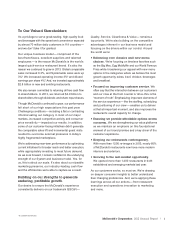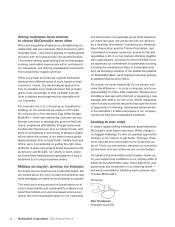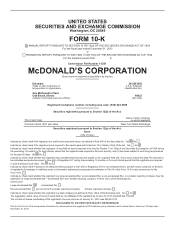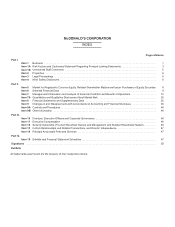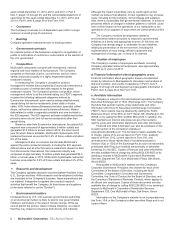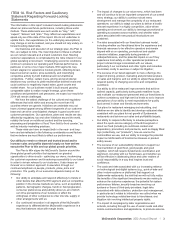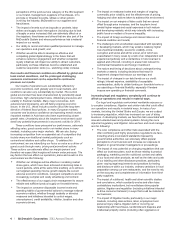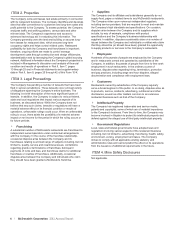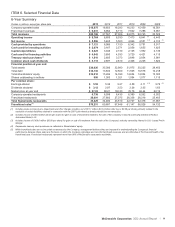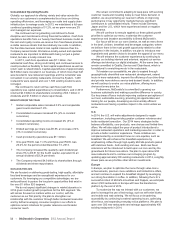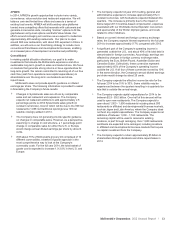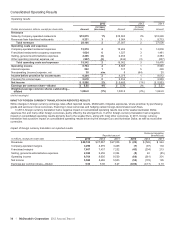McDonalds 2013 Annual Report Download - page 12
Download and view the complete annual report
Please find page 12 of the 2013 McDonalds annual report below. You can navigate through the pages in the report by either clicking on the pages listed below, or by using the keyword search tool below to find specific information within the annual report.
4 | McDonald’s Corporation 2013 Annual Report
perceptions of the quick-service category of the IEO segment
or our brand, management, suppliers or franchisees, or to
promote or threaten boycotts, strikes or other actions
involving the industry, McDonald’s or our suppliers and
franchisees;
The impact of events such as boycotts or protests, labor
strikes and supply chain interruptions (including due to lack
of supply or price increases) that can adversely affect us or
the suppliers, franchisees and others that are also part of the
McDonald's System and whose performance has a material
impact on our results;
Our ability to recruit and retain qualified personnel to manage
our operations and growth; and
Whether we will be able to develop an effective and
compelling global digital strategy in the future that will
enhance customer engagement and whether competitor
loyalty initiatives will impact our ability to attract customers,
particularly as these initiatives become established and
customer acquisition costs (i.e., switching costs) increase.
Our results and financial condition are affected by global and
local market conditions, and the prolonged challenging
economic environment can be expected to continue to
pressure our results.
Our results of operations are substantially affected by
economic conditions, both globally and in local markets, and
conditions can also vary substantially by market. The current
global environment has been characterized by persistently weak
economies, high unemployment rates, inflationary pressures and
volatility in financial markets. Many major economies, both
advanced and developing, are still facing ongoing economic
issues. In the U.S., these include concerns about the long-term
direction of federal fiscal policies. In many European markets,
consumer and business confidence and spending remain muted.
Important markets in Asia have also been experiencing slower
growth rates. Uncertainty about the long-term environment could
derail any potential improvements in economic activity for 2014.
These conditions have pressured our performance, adversely
affecting sales, guest counts and/or our market share in many
markets, including some major markets. We are also facing
increasing competition from an expanded set of competitors that
include many non-traditional market participants such as
conventional retailers and coffee shops. To address this
environment, we are intensifying our focus on value as a driver of
guest counts through menu, pricing and promotional actions.
These actions can adversely affect our margin percent and
therefore we expect that margins will remain under pressure. The
key factors that can affect our operations, plans and results in this
environment are the following:
Whether our strategies will be effective in enabling market
share gains, which have been achieved at declining rates in
recent periods, while at the same time enabling us to achieve
our targeted operating income growth despite the current
adverse economic conditions, resurgent competitors and an
increasingly complex and costly advertising environment;
The effectiveness of our supply chain management to assure
reliable and sufficient product supply on favorable terms;
The impact on consumer disposable income levels and
spending habits of governmental actions to manage national
economic matters, whether through austerity or stimulus
measures and initiatives intended to control wages,
unemployment, credit availability, inflation, taxation and other
economic drivers;
The impact on restaurant sales and margins of ongoing
commodity price volatility, and the effectiveness of pricing,
hedging and other actions taken to address this environment;
The impact on our margins of labor costs that we cannot
offset through price increases, and the long-term trend
toward higher wages and social expenses in both mature
and developing markets, which may intensify with increasing
public focus on matters of income inequality;
The impact of foreign exchange and interest rates on our
financial condition and results;
The challenges and uncertainties associated with operating
in developing markets, which may entail a relatively higher
risk of political instability, economic volatility, crime,
corruption and social and ethnic unrest, all of which are
exacerbated in many cases by a lack of an independent and
experienced judiciary and uncertainties in how local law is
applied and enforced, including in areas most relevant to
commercial transactions and foreign investment;
The nature and timing of decisions about underperforming
markets or assets, including decisions that result in
impairment charges that reduce our earnings; and
The impact of changes in our debt levels on our credit
ratings, interest expense, availability of acceptable
counterparties, ability to obtain funding on favorable terms or
our operating or financial flexibility, especially if lenders
impose new operating or financial covenants.
Increasing legal and regulatory complexity will continue to
affect our operations and results in material ways.
Our legal and regulatory environment worldwide exposes us
to complex compliance, litigation and similar risks that could affect
our operations and results in material ways. In many of our
markets, including the United States and Europe, we are subject
to increasing regulation, which has increased our cost of doing
business. In developing markets, we face the risks associated with
new and untested laws and judicial systems. Among the more
important regulatory and litigation risks we face and must manage
are the following:
The cost, compliance and other risks associated with the
often conflicting and highly prescriptive regulations we face,
including where inconsistent standards imposed by
governmental authorities can adversely affect popular
perceptions of our business and increase our exposure to
litigation or governmental investigations or proceedings;
The impact of new, potential or changing regulations that can
affect our business plans, such as those relating to product
packaging, marketing and the nutritional content and safety
of our food and other products, as well as the risks and costs
of our labeling and other disclosure practices, particularly
given varying legal requirements and practices for testing
and disclosure within our industry, ordinary variations in food
preparation among our own restaurants, and the need to rely
on the accuracy and completeness of information from third-
party suppliers;
The impact of nutritional, health and other scientific studies
and conclusions, which constantly evolve and often have
contradictory implications, but nonetheless drive popular
opinion, litigation and regulation (including initiatives intended
to drive consumer behavior) in ways that could be material to
our business;
The impact of litigation trends, particularly in our major
markets, including class actions, labor, employment and
personal injury claims, litigation with or involving our
relationship with franchisees, landlord/tenant disputes and
intellectual property claims (including often aggressive or



